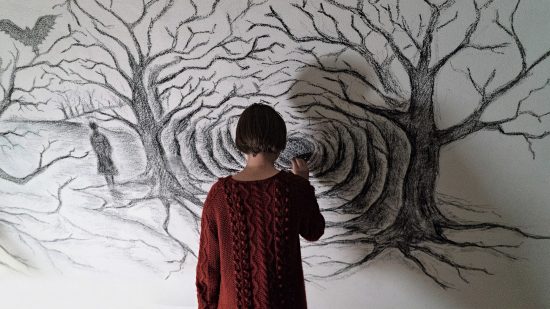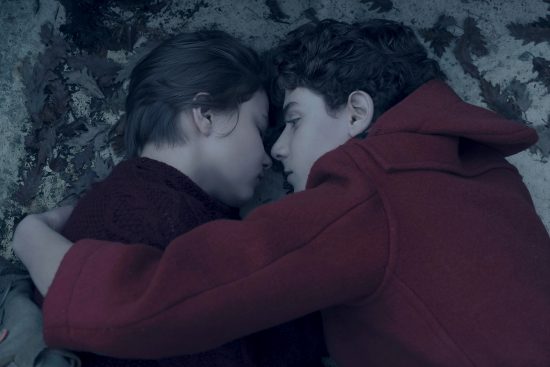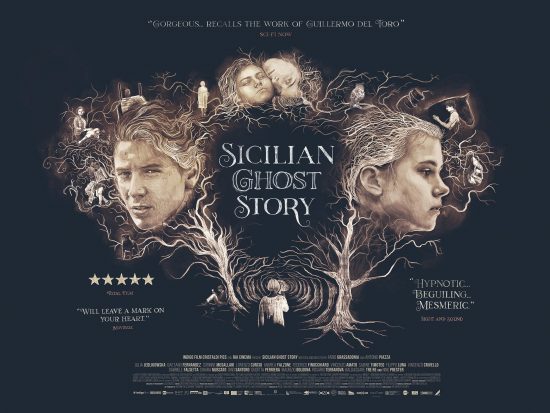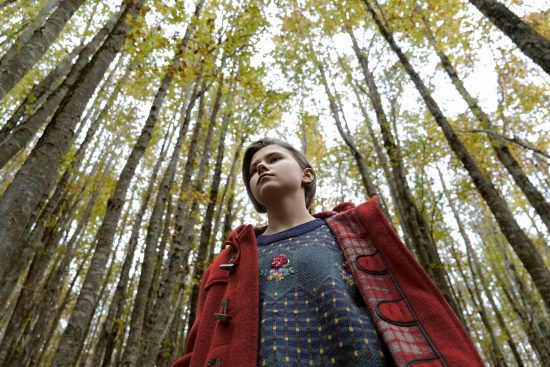Behind the scenes of Sicilian Ghost Story with filmmakers Fabio Grassadonia and Antonio Piazza
What if you blend in real-life crime drama with the horror and fantasy elements of the supernatural and wrap it all up in an elegiac ode to the healing power of nature’s beauty? That’s exactly what Fabio Grassadonia and Antonio Piazza have done with their new cinematic effort, Sicilian Ghost Story, based on the short story “Il Cavaliere Bianco” (The White Knight) by Italian author Marco Mancassola, which is part of his short stories collection titled “Non Saremo Confusi Per Sempre” (We won’t be confused forever).
In a Sicilian small town nested on the mountains, surrounded by thick forests and vast lakes, Luna is hopelessly in love with classmate Giuseppe and one day she decides to follow him after school to give him a love letter. Giuseppe smokes her out and to Luna’s surprise, asks her to join him at the stables for a horse-riding session. The young girl is ecstatic at the opportunity but what could be the start of an adorable young romance quickly becomes a descent into a living nightmare. Giuseppe is kidnapped under her nose and no one seems to care or do anything about it, prompting her to start a desperate search, which will lead her on a dark and dangerous path and ignite her otherworldly connection with the boy.
In 2013 Sicilian filmmakers Grassadonia and Piazza won the Critics Week Grand Prize at Cannes Film Festival for their feature debut, Salvo, an interesting spin on the rather common mafia narrative in Italian cinema. The fact that Sicilian Ghost Story tackles another mafia-related tale could be seen as playing it safe, yet with their latest opus these brilliant writers/directors have crafted one of the most original and deeply moving films you’ll see this year.
The true story behind the source material and the film is probably the most harrowing tale of horror that occurred at the height of Sicilian mafia’s activity in the early 90s. In November 1993, 11-year-old Giuseppe Di Matteo, the son of mafia’s “pentito” (supergrass) Santino Di Matteo, was kidnapped by Mafioso Giovanni Brusca as an act of retaliation when Di Matteo became a key police informant about the infamous fatal attack on anti-mafia Sicilian judge Giovanni Falcone.
For those who are not familiar with the events and would like to avoid spoilers, we won’t get into any more details, although it’s not hard to imagine how this story lacks a happy ending. Yet the filmmakers’ and the author’s purpose in approaching this tragic piece of recent Sicilian history was indeed to pay a loving tribute to the innocent soul of a child who fell victim to the senseless, barbaric stupidity of mankind’s worst.
Being Sicilian born and raised, I was 13 years old at the time of Giuseppe Di Matteo’s kidnapping. I have a vivid memory of those horrifying peak years in mafia’s history and of that particularly undignified episode, which still haunts me. That’s why I’ve never been a huge fan of American cinema glorifying mafia villains and I still get rather sensitive whenever I hear the association “Sicilia-mafia” upon revealing where I’m from.
The greatest gift of a film like Sicilian Ghost Story is indeed that of paying an overdue loving homage to an innocent young soul whose life was broken in the cruelest and unfair of ways. However, after watching it and balling my eyes out during the closing credits, I felt like the film was also a gift to us Sicilians who need a hopeful redemption for our beautiful yet mostly abused and neglected homeland.
I had the utmost pleasure of chatting with my fellow Sicilians Fabio Grassadonia and Antonio Piazza when their film screened at the BFI London Film Festival almost a year ago and they were extremely generous, delving behind the scenes of their brilliant work of art. Reading the short story was indeed a crucial moment for the filmmakers because the real story of Giuseppe Di Matteo had always been in their minds. They didn’t know each other at the time but somehow they both decided to leave Sicily and move to Turin in the North of Italy, where they met after Giuseppe’s kidnapping occurred.
“This story is the epitome of the horror of those Sicilian years for the circumstances of the kidnapping and the way things developed. It represents the horror but also the stupidity and the absurd senselessness of such a heinous crime. However, despite it being so emblematic, we actually hadn’t planned to make a film about the Di Matteo case because it would’ve just been a mere repetition of its horror. Then in 2011, even before making our feature debut Salvo, we read Marco Mancassola’s short story and that was indeed the moment when we felt like if we were going to be able to make another film, then it would be that one.”
Mancassola’s book is a collection of short stories based on rather tragic and hopeless real life events in Italy’s recent history. The author’s intuition on a literary level was that of introducing a fantasy element that allows a form of redemption for the victims. Giuseppe’s story is told through the eyes of a fictitious classmate, Luna (Julia Jedilikowska), who has fallen in love with the boy (played by Gaetano Fernandez) and for the filmmakers that was indeed the key element to build the film on.
“The short story actually continues into another direction because it follows Luna and her obsession with Giuseppe’s tragic story all the way to her adult age. However we were interested in focusing on the 779 days of the kidnapping, put ourselves in these kids’ shoes and tell the whole story through their point of view, everything they could and couldn’t know at the time. The adaptation work focused on that. The essential ideas and themes of the source material are still there because we tell the story through Luna and she ignites the fantasy element, which belongs to her mind, her dreams and her imagination.”
The filmmakers’ motivations behind wanting to make this film started with their need to craft an act of love towards this kid who never had the chance to experience love in his life, hence the choice of telling the story through the point of view of a girl who’s in love with him. They also wanted to make the film with Sicilian kids of the same age.
“We thought that in order to tell this story we needed to find a way to really convey what these kids were experiencing in the form of an intense emotional journey. So we lead the audience in by making them think they’re watching a simple story of first love and then we gradually push them into hell. We wanted to allow the audience to set aside any intellectual filter and get on board with the emotional voyage of two kids who find themselves stuck in two different kinds of prisons that are equally horrific and suffocating and despite all this they find a way to not betray themselves and save their own human dignity, thanks to the romantic relationship that remains unfulfilled.”
In order to handle such delicate topics, Grassadonia and Piazza’s cinematic style heavily relies on aesthetic beauty, even when dealing with such a harrowing and dark story: “We believe in beauty. Beauty for us is a form of resistance against violence and brutality and against all sorts of ugliness that surrounds us, both the visible one and the moral kind. We express that in our film, which in essence is a testament to the beauty of these kids’ souls and also to the beauty of some natural landscapes in Sicily that remain pristine and to work of arts like those ancient Greek temples that still have resisted over thousands of years as a symbol of something that endures in spite of it all, something that can’t be destroyed and goes beyond the human experience. Our style is definitely linked to this idea and so are the cinematic influences we had for this film.”
One of their stylistic references was undoubtedly Guillermo Del Toro’s Pan’s Labyrinth, which is an illustrious case of a film that combines a fantasy element with history and real life events. Another one was The Night of the Hunter by Charles Laughton whose aesthetics are really interesting as it’s filled with expressionist lighting and the eerie location by the river with the kids fleeing from evil thanks to the water. It’s also a film that interested them from a structural standpoint since it’s built on various levels of storytelling and with several hidden narrators, a bit like Sicilian Ghost Story, which doesn’t have a linear narration.
“We also shared with our director of photography Luca Bigazzi some artistic references not just in paintings but also in photography. One in particular was Full Moon, the photographic book by Darren Almond who takes photos overnight by keeping the shutter open. The camera accumulates light over the hours rather slowly and the nocturnal landscapes wind up transforming into something different. There is light but it’s a light that despite looking like dawn, it’s not really dawn. It’s like a sort of time that doesn’t exist, which is indeed the time we wanted to create through Luna and Giuseppe’s imagination. They meet in this time or dimension thanks to their love but this time/dimension actually doesn’t exist because their meeting is impossible.”
For the filmmakers it was extremely important to be able to create the emotional and sensorial experience of these kids’ story. They think this is one of the possible ways to bring back to the cinema those young generations who no longer go see a film in a movie theater unless it’s some big blockbuster. In fact they were stunned by the reactions to the film from the special screenings they arranged for schools.
“It was deeply satisfying not just to see young audiences becoming enthralled with the story of these two Sicilian Romeo and Juliet and wanting to learn more about Giuseppe Di Matteo’s case but it was especially rewarding to see them appreciate watching the film on the big screen and realize that such audiovisual sensorial experience and its emotional ramifications would’ve been lost if they had watched the film on a laptop or a phone.”
Speaking of working with young kids, the casting process was long and difficult. It lasted nine months and the directors also met the kids’ families because they wanted to clarify with them a very important aspect of their work. “For starters we should mention how these kids today are not really affected by the thought of the mafia, given the current form this entity has evolved into. They don’t have a perception of the mafia as something still existing around them, for better and for worse. We set off to craft an act of love for Giuseppe and so we had no intention of turning these Sicilian kids into ‘actors’ but we wanted to figure out how these kids could bring their innocence, beauty and humanity to the project. In order to do that we needed time so we asked the parents to entrusts us with their children in the summer after school ended to take them with us on a workshop retreat in the mountains where we were going to eventually shoot the film.”
The directors intentionally gathered a rather diversified group of kids with totally different backgrounds, origins and social status. That was important to them because in real life most likely these kids would never have met but thanks to this experience they wound up spending some quality time together: “At the beginning, being together on this workshop retreat was a way of breaking the ice, getting to know each other and show them that we were all on the same level, including us filmmakers, so that we all had to be open to get to know each other and all of our personal limitations. It was a way to prepare them for the fact that we weren’t looking for kids that were going to try and be actors and end up overacting.”
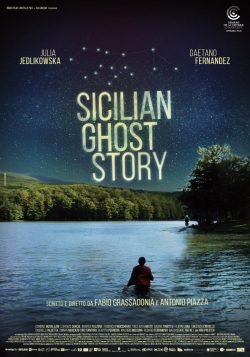 Over the first few weeks the filmmakers didn’t even address the script or the real life story of Giuseppe Di Matteo. The kids were not aware of what the film was going to be about. Then, after they finally let their guards down and started to show their vulnerability and genuine selves, trusting the directors and being ready to get to know each other and challenge themselves, that’s when Grassadonia and Piazza first tackled the script, even before the true story.
Over the first few weeks the filmmakers didn’t even address the script or the real life story of Giuseppe Di Matteo. The kids were not aware of what the film was going to be about. Then, after they finally let their guards down and started to show their vulnerability and genuine selves, trusting the directors and being ready to get to know each other and challenge themselves, that’s when Grassadonia and Piazza first tackled the script, even before the true story.
“That was a crucial moment for us since our way of writing scripts is rather precise and technical, with directorial references, and so we were afraid they could have trouble getting into it but actually, reading the script had an extremely emotional impact on them. That’s when we introduced Giuseppe’s real life story and his dark fate and that stimulated a comparison between their own experience of being willingly in a retreat up on the mountains with us, away from their families, and the horrible kind of segregation that Giuseppe had been forced into.
We explained to them with open heart that our intention in making this film was a mission. And this wasn’t a mission to repair something because unfortunately there was nothing about Giuseppe’s horrible tragedy that could be fixed but it was a mission to create a tribute, an act of love for Giuseppe. That’s when we asked them if they wanted to get on board with us to accomplish this mission by forgetting about their personal problems and limitations and just focus 100% on this mission and they accepted.”
Since then the directors started to work on getting deeper into the script, deconstructing the story, analyzing themes and improvising on the characters with the kids, building from what was on the page. Eventually they wound up writing the final two drafts of the script with the kids in order to adapt the dialogue and the situations to their own experiences and way of being: “What we accomplished with all this work was helping these kids emerge within those characters, without ever forcing them to mimic anything, so when we finally got on set it was amazing to see them at work, especially for the crew who thought they were extremely disciplined and professional. The greatest gift for us was to see the kids who were more insecure at the beginning finally let loose and let their talent bloom and most importantly realise that when they apply themselves to something with every fiber of their being, they unlock undiscovered qualities which all come from the resilience of never getting content with what they can do and working hard to reach the impossible.
For us as well it was a life-changing experience on a human level, especially after spending so much time by ourselves doing research, buried in the darkness and the horror of the real events. By working with these kids and creating this film, we felt like we were able to bring Giuseppe back to the light and for all of us that was a source of immense joy. Maybe it’s too much to expect that cinema and art in general can change the world, especially nowadays when cinema is not as central in our lives as it used to be. However it can certainly have an impact on some people like we’ve seen for instance during our school screenings and that’s already important.”
One of the most personal and original films of the year, Sicilian Ghost Story is nothing you’ll ever expect from an Italian film handling yet again a true story of mafia-related crime. As someone born and raised in Palermo, this is a film that makes me proud of being Sicilian. Smart, compelling, humourous, nostalgic of a period I’ve lived first hand and extremely moving, Sicilian Ghost Story gets under your skin and haunts you for days after the screen cuts to black. An exquisitely-crafted, imaginative re-telling of a chilling and despicable episode of Sicilian “cronaca nera”, filmmakers Fabio Grassadonia and Antonio Piazza deserve praise for finding a brilliant and deeply touching way to homage the memory of Giuseppe Di Matteo, educate the new generations on their dark history and send the powerful message of hope that the light will prevail in the end.
Sicilian Ghost Story is in UK cinemas and on digital from August 3rd via Altitude Films

